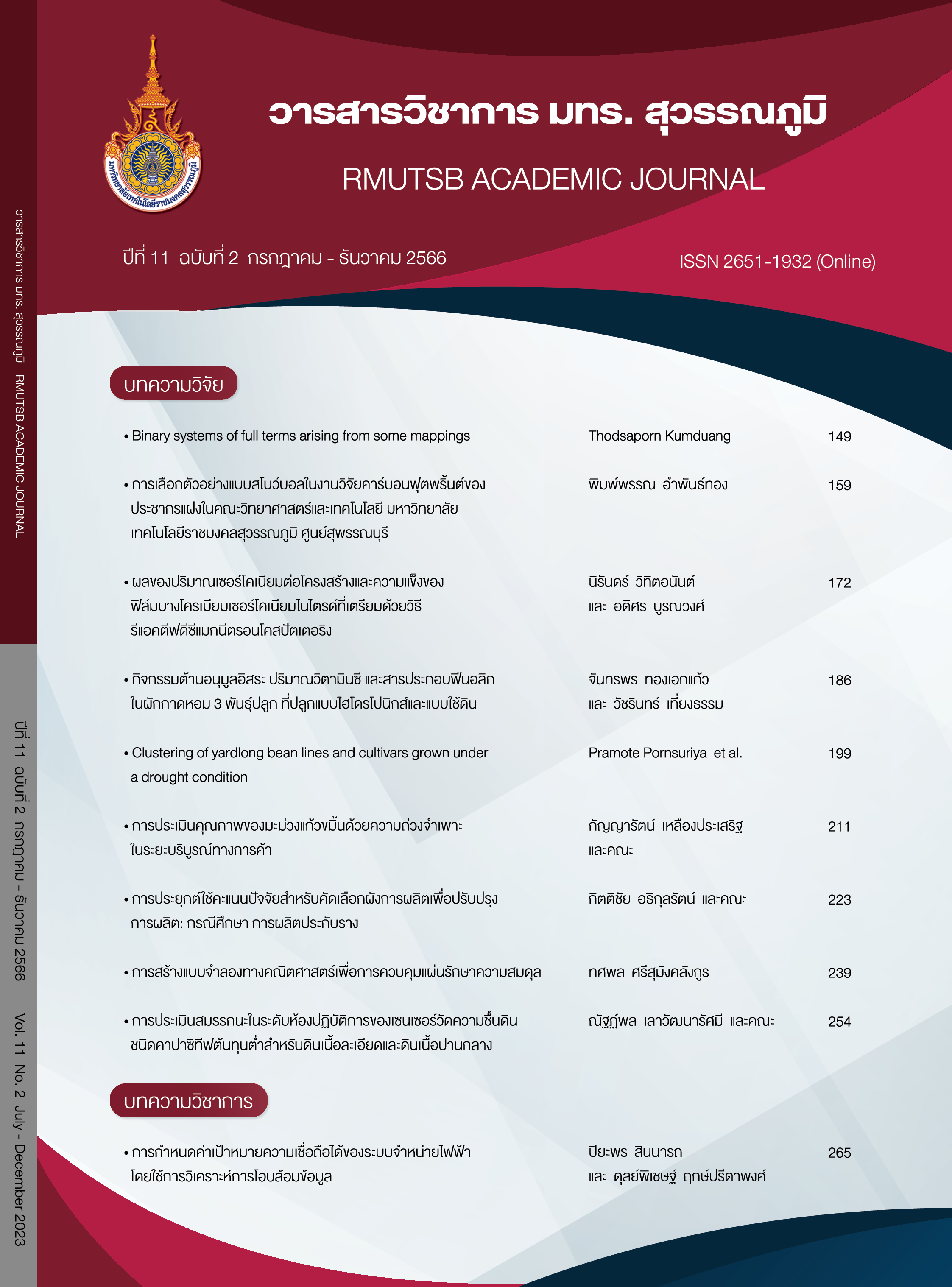Effect of Zr content on the structure and hardness of CrZrN thin films prepared by reactive DC magnetron co-sputtering method
Main Article Content
Abstract
In this research work, a nanostructured chromium zirconium nitride (CrZrN) thin film was deposited on Si(100) by reactive DC magnetron co-sputtering method at room temperature. The effects of zirconium content on the structure and hardness of the as-deposited thin films by varying the sputtering currents applied to the Zr target (IZr) in the range of 300 mA to 900 mA, while the current of Cr target (ICr) was kept at 300 mA were investigated. The crystal structure, microstructure, morphology, thickness, and chemical composition were characterized by X-ray diffraction (XRD), Field Emission Scanning Electron Microscopy (FE-SEM), and Energy-Dispersive X-ray Spectroscopy (EDS) techniques, respectively. The results showed that increases in Izr enhanced the deposition rate from 7.9 nm/min to 17.9 nm/min and increased the Zr content in the as-deposited films from 6.71 at% to 45.91 at%. The as-deposited films were formed as a (Cr, Zr) N solid solution, with fcc structure in (111), (200), and (220) planes. The lattice constant increased from 4.164 Å to 4.485 Å, whereas the average crystallite size decreased from 9.8 nm to 2.8 nm, showing that the as-deposited film has a nanocrystalline. The FE-SEM micro-images of all the CrZrN thin films showed compact columnar structure and dense morphology as a result of various Zr content in the films. Moreover, the thickness of the thin films was in the range of 475-1075 nm. The as-deposited film in this research work composed of chromium, zirconium, and nitrogen in different ratios, depending on Izr. The hardness of films measured by the nano-indentation technique increased from 9.1 GPa to 18.6 GPa with respect to an increase in zirconium content and a decrease in average crystallite size.
Article Details

This work is licensed under a Creative Commons Attribution-NonCommercial-NoDerivatives 4.0 International License.
Published manuscript are the rights of their original owners and RMUTSB Academic Journal. The manuscript content belongs to the authors' idea, it is not the opinion of the journal's committee and not the responsibility of Rajamangala University of Technology Suvarnabhumi
References
Alaksanasuwan, S., Buranawong, A., & Witit-anun, N. (2020). Effect of total pressure on the structure and hydrophilic property of TiO2 thin film prepared by reactive DC magnetron sputtering method. RMUTSB Academic Journal, 8(2), 240-254. (in Thai)
Chantharangsi, C., Denchitcharoen, S., Chaiyakun, S., & Limsuwan, P. (2015). Structure, morphologies, and chemicalstates of sputter-deposited CrZrN thin films with various Zr contents. Thin Solid Films, 589, 613-619.
Feng, X. G., Zhang, K. F., Zheng, Y. G., Zhou, H., & Wan, Z. H. (2018). Structure, morphologies and mechanical properties study of Cr-Zr-N films. Nuclear Instruments and Methods in Physics Research B, 436, 112-118.
Franz, R., & Mitterer, C. (2013). Vanadium containing self-adaptive low-friction hard coatings for high-temperature applications: A review. Surface and Coatings Technology, 228, 1-13.
Khambun, A., Buranawong, A., & Witit-anun, N. (2017). Structural characterization of reactive DC magnetron Co-sputtered nanocrystalline CrAlN thin film. Key Engineering Materials, 751, 84-87.
Khamseh, S., & Araghi, H. (2016). A study of the oxidation behavior of CrN and CrZrN ceramic thin films prepared in a magnetron sputtering system. Ceramics International, 42, 9988-9994.
Krelling, A. P., Da Costa, C. E., Milan, J. C. G., & Almeida, E. A. S. (2017). Micro-abrasive wear mechanisms of borided AISI 1020 steel. Tribology International, 111, 234-242.
Kusano, E. (2019). Structure-zone modeling of sputter-deposited thin films: a brief review. Applied Science and Convergence Technology, 28(6), 179-185.
Leasen, S., & Boonyopakorn, N. (2017). The effect of RF power on crystal structure and electrical properties of aluminum-doped zinc oxide films prepared by RF magnetron sputtering technique. RMUTSB Academic Journal, 5(2), 129-135. (in Thai)
Leelaruedee, K., Kuwahara, H., Khamkongkaeo, A., Yongvanich, N., Chanlek, N., Kidkhunthod, P., Leelachao, S., & Visuttipitukul, P. (2020). Effect of zirconium addition on the phase evolution of chromium zirconium nitride prepared by magnetron sputtering. Materials Testing, 62(8), 783-787.
Musil, J. (2012). Hard nanocomposite coatings: Thermal stability, oxidation resistance and toughness. Surface & Coatings Technology, 207, 50-65.
Paksunchai, C., Denchitcharoen, S., Chaiyakun, S., & Limsuwan, P. (2014). Growth and characterization of nanostructured TiCrN films prepared by DC magnetron Co-sputtering. Journal of Nanomaterials, 2014, 609482.
Santecchia, E., Hamouda, A. M. S., Musharavati, F., Zalnezhad, E., Cabibbo, M., & Spigarelli, S. (2015). Wear resistance investigation of titanium nitride-based coatings. Ceramics International, 41, 10349-10379.
Sukwisute, P., Sakdanuphab, R., & Sakulkalavek, A. (2017). Hardness and wear resistance improvement of ABS surface by CrN thin film. Materialstoday: Proceedings, 4(5), 6553-6561.
Witit-anun, N., Khambun, A., Alaksanasuwan, S., & Buranawong, A. (2020). Effect of sputtering current on the structure of titanium nitride thin film deposited by reactive DC magnetron sputtering. Burapha Science Journal, 25(1), 387-399. (in Thai)


